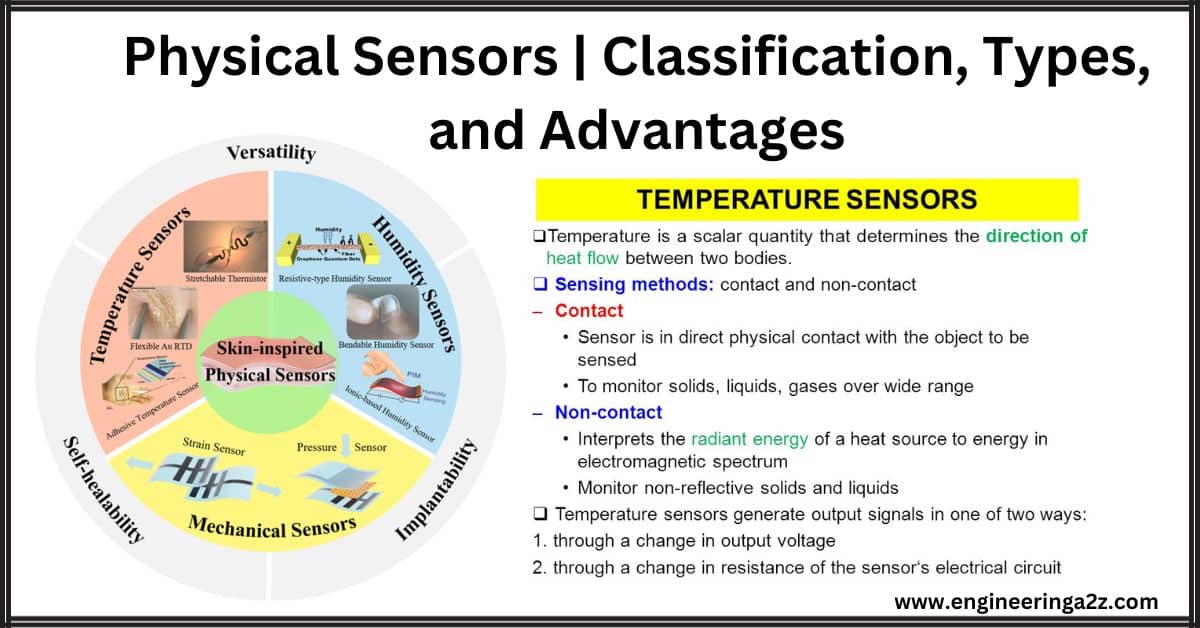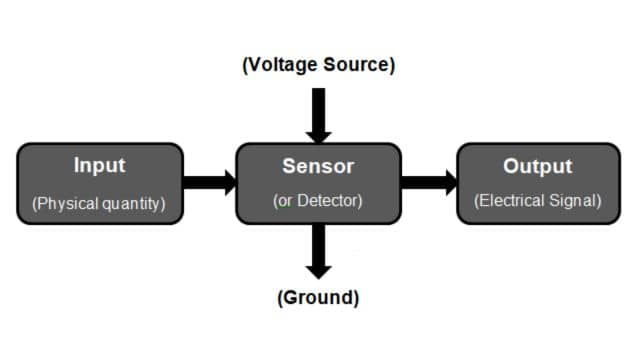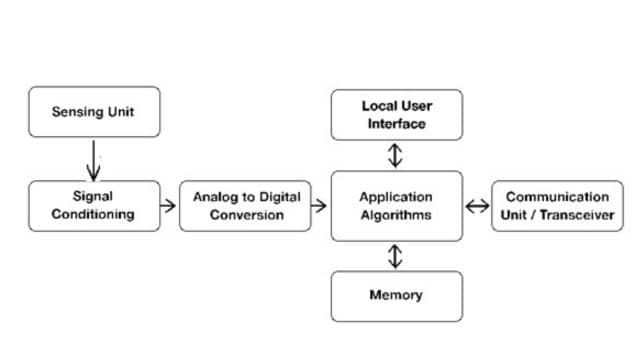
Table of Contents
Introduction
Physical sensors are devices that detect and respond to physical input from the environment. They convert various types of physical quantities, such as light, temperature, pressure, motion, or proximity, into electrical signals or data that can be interpreted by a computer or electronic system.

Classification Of Sensors
Imagine sensors are like different types of detectives with their unique ways of solving mysteries.
- Active and Passive Sensors:
- Active Sensors: These detectives need a power boost or a signal to start their investigation.
- Passive Sensors: They’re the natural detectives who can investigate without needing any extra power. They just jump into action on their own.
- Means of Detection:
- Electric, Biological, Chemical, Radioactive, etc.: Each detective has their favourite way of detecting clues. Some use electricity, some use biology, others use chemicals, and some even use radioactivity to solve the mystery.
- Conversion Phenomena:
- Photoelectric, Thermoelectric, Electrochemical, etc.: Just like detectives have their special skills, these sensors have unique ways of turning what they find into useful information. Some use light, some use heat, some use chemical reactions, and so on.
- Analog and Digital Sensors:
- Analog Sensors: Think of these detectives as ones who give you a smooth story. They provide information that flows continuously, like telling a story without pauses.
- Digital Sensors: These detectives tell their story in pieces. They work with bits of information—like writing a story by arranging letters or numbers—giving specific and clear details but in small chunks.

Different Types Of Sensors
The following is a list of different types of sensors:
- Temperature Sensor: This tool helps us figure out how hot or cold something is.
- Proximity Sensor: It’s like a detective’s radar, detecting if something is nearby without touching it.
- Accelerometer: This tool feels movements, like a detective sensing if someone’s jumping, running, or sitting still.
- IR Sensor (Infrared Sensor): This one sees things that are too dark or far away for our eyes to spot.
- Pressure Sensor: It’s like a detective’s hand, feeling how hard something is pushing or squeezing.
- Light Sensor: This tool notices how bright or dark a place is, almost like a detective’s eyes.
- Ultrasonic Sensor: It sends out sound waves to measure distances like a detective shouting to see how far away something is.
- Smoke, Gas, and Alcohol Sensor: These are like detectives for smells—they detect if something’s in the air that shouldn’t be.
- Touch Sensor: This one feels when something is touched or pressed, just like a detective feeling for clues.
- Color Sensor: It notices the colors of things, just like a detective studying the color of clothes or objects.
- Humidity Sensor: It’s like a detective for moisture, figuring out how damp or dry the air is.
- Position Sensor: This tool knows if something has moved or changed position, like a detective marking where things are.
- Magnetic Sensor (Hall Effect Sensor): It detects invisible magnetic fields, like a detective using a special tool to find hidden clues.
- Microphone (Sound Sensor): This one hears noises and sounds, like a detective listening for clues or conversations.
- Tilt Sensor: It feels when something tilts or moves in a particular direction, just like a detective sensing if something is leaning.
- Flow and Level Sensor: These tools measure how much of something is moving or how much there is of it like a detective gauging the flow of water in a river.
- PIR Sensor: It detects heat or motion in a room, like a detective sensing if someone’s inside without even seeing them.
- Strain and Weight Sensor: These sense if something is being stretched, bent, or how heavy something is, just like a detective weighing evidence.
Real-Time Application of Sensors
Imagine an autopilot system in an airplane like the brain and senses of a pilot. The system has “sensors,” which are like its eyes and ears. These sensors keep an eye on important things during the flight, like how fast the plane is going, how high it is in the sky, whether the doors are closed, if there’s anything in the way, and how much fuel is left.
All this information goes to a “computer,” which is like the brain. This computer compares what the sensors see and hear with what it’s supposed to be according to the flight plan. If something doesn’t match up, the computer sends messages to the different parts of the plane, like the engines, flaps, and other controls, to make adjustments. For instance, if the plane needs to go higher, the computer tells the engines to speed up or the flaps to move.
This way, the sensors keep an eye on everything, the computer thinks about what needs to happen, and the mechanics (like engines and flaps) follow the computer’s instructions to keep the flight smooth and safe.
Though this is a simple way to understand it, in reality, there are loads of different sensors doing specific jobs to ensure a safe and comfortable flight. But for our lesson today, we’re focusing on the sensors and learning about their types, how they work, and how they’re used in an autopilot system.
Advantages Of Physical Sensors
- Accurate Data Collection: Sensors are like super-precise tools that measure things exactly, just like using a ruler to measure how long something is. They tell us exactly how hot, cold, heavy, bright, or dark something is.
- Automation and Control: Sensors work like eyes and ears for machines. They give constant updates about what’s happening right now, helping machines make quick decisions without needing someone to tell them what to do.
- Improved Safety: Sensors are like alarm systems that can detect dangers. They can warn us if something dangerous, like smoke or too much heat, is happening so we can stay safe. It’s like having a superhero sense danger before it becomes a big problem!
Frequently Asked Questions (FAQs)
What are the physical properties of a sensor?
Physical properties of sensors include size, shape, material composition, sensitivity, range, response time, operating temperature, and the ability to withstand environmental conditions or mechanical stress.
What are the physical variables of a sensor?
Physical variables that sensors can detect include temperature, pressure, light intensity, humidity, force, acceleration, displacement, proximity, flow, sound, and electromagnetic fields among others.
What are the 4 main types of sensors?
The four main types of sensors are:
1. Temperature Sensors: These detect changes in temperature.
2. Proximity Sensors: They detect nearby objects or changes in distance.
3. Pressure Sensors: These measure force applied per unit area.
4. Motion Sensors: These detect movement or changes in position.
Read Also:
- Advanced Electric Drives Notes | Engineeringa2z
- Starting and Speed Control Methods of 3-Phase Induction Motors
- Motor Braking | Types, Advantages, and, Applications
- Electric Traction | Speed-Time Curve
- Difference Between AC and DC Welding





Leave a Reply